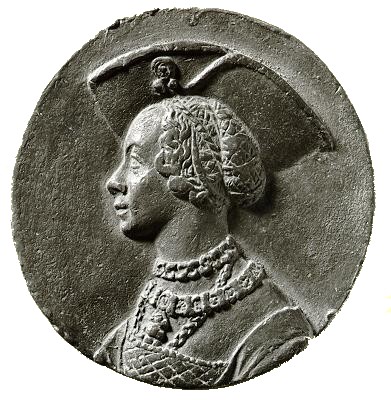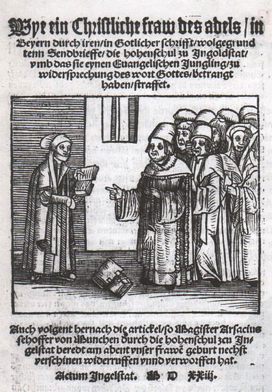Forgetting and Remembering the Reformation’s First Female Pamphleteer
In 1523 and 1524, a series of German letters challenged ecclesiastical leaders by asserting the individual’s right to interpret Scripture. These publications found a wide audience, and as many as 30,000 copies soon circulated. The letters, eight in total, were addressed to audiences ranging from theologians to magistrates to commoners.
The opening salvo against the University of Ingolstadt contained many controversial claims:
— ‘You lofty experts, nowhere in the Bible do you find that Christ, or his apostles, or his prophets put people in prison, burnt or murdered them, or sent them into exile’.
— ‘One knows very well the importance of one’s duty to obey the authorities. But where the word of God is concerned neither Pope, Emperor nor princes ... have any jurisdiction’.
— ‘We have witness enough from Scripture that they have no right to make laws without God’s command’.
— ‘[N]o one has a right to exercise sovereignty over the word of God. Yes, no human being, whoever he be, can rule over it. For the word of God alone ... should and must rule’.
— ‘A disputation is easily won when one argues with force, not Scripture. As far as I can see that means that the hangman is accounted the most learned’.
These assertions flowed from the quill of a lay pamphleteer, not a monk; from a neglected Reformer, not a famous one; from a woman, not a man. Protestant female pamphleteering, in other words, was almost as old as Protestantism itself.

Argula von Grumbach (c. 1492–c. 1554) wrote at a time of increasing anxiety over the destabilising nature of evangelical ideas; at a time when authorities tried unsuccessfully to coax heterodoxy back into Pandora’s box. In this context, the theological faculty of Ingolstadt arrested a young scholar, Arsacius Seehofer, for unorthodox sympathies. Ingolstadt boasted Martin Luther’s famous interlocutor, Johannes Eck. Seehofer caved under pressure and renounced Lutheran views, sparking protest among his supporters.
Argula von Grumbach (a Bavarian noblewoman born into the Stauffen family) took notice. She travelled to Nuremberg to discuss the matter with the Reformer Andreas Osiander in September 1523, and they may have spoken of her intention to confront Ingolstadt. She soon wrote two letters that displayed her capacious grasp of Scripture: the first to the university; the second to Duke Wilhelm IV (of Bavaria). Princes, she told Wilhelm, should not be ‘led along like monkeys on a chain by these so called spiritual rulers’.
Publication of these letters, she later claimed, took place without her knowledge, but ‘now I see that God wishes to have it made public’. She then harnessed the printing press for her cause (her first letter quickly went through 14 editions). One edition depicted her alone, holding Scripture, instructing the teachers of canon law (their books lying on the ground). She said she did ‘not flinch from appearing before you, from listening to you, from discussing with you’. However, her ‘Here I stand’ moment before the faculty never came. They would not engage.

One ‘Johannes of Lanzhut’ chose denunciation rather than understanding; mockery instead of refutation; misogyny instead of persuasion, all tightly wound into 65 rhyming couplets. She poetically responded, reiterating her ideas and defending her reputation.
Although her beliefs and behaviour, in Ingolstadt’s estimation, were not worthy of debate, they found them deserving of punishment. They penalised her husband and tried to pressure him into silencing her. ‘I cannot help that’ opponents resorted to coercion, she wrote to a disapproving family member before comparing herself with Jesus: ‘I weighed everything up carefully, as was the case with Pilate. I am prepared to lose everything — even life and limb. May God stand by me!’
Throughout her writings, she emphasised her prophetic role. She called for spiritual warfare, warned of judgement, denounced the damned and interpreted events eschatologically. Her publications defended her character, nobility and Christian witness by countering accusations. Opponents claimed she defied God, disrespected authority, disgraced the female sex and neglected her family. In any event, the Peasants’ War erupted at the height of her influence, and popular unrest made it more dangerous to be an author on the margins.
By what right did Argula von Grumbach make her stand? Necessity, she argued, propelled her forward: ‘I cannot see any man who is up to it’. God frequently spoke through unlikely mouthpieces, and she cited Deborah, Jael, Esther, Judith and even Balaam’s female donkey (who spoke more wisdom than the rider).
Two theological pillars supported her resolve: the priesthood of every believer and Scripture alone as a guide for faith and practice. She claimed continuity with Luther, but not dependence on him. As noted by G. Sujin Pak in The Reformation of Prophecy, ‘The majority of lay pamphleteers taking up their pens in active embodiment of the priesthood of all believers were men. Yet scholars note that the years 1523 to 1524 demonstrate a remarkable outpouring of treatises written by women’. Luther himself included them in this priesthood. Second, she stood on Scripture alone: ‘Their pamphlets were so saturated with biblical citations that the female author quite literally proclaimed the Word of God’.
Her publications brought notoriety. Count Palatine Johann von Simmern invited Argula to speak in Nuremberg while the imperial diet met in 1523. Some Reformers, like Luther, followed the events at Ingolstadt closely and admired her courage. The two met in 1530. She corresponded with many Reformers and educated her children in the faith. Although she withdrew from the public eye, authorities imprisoned her in old age for beliefs and practices that undermined Catholic teachings.
Most who remembered the Reformation forgot Argula. However, as Peter Matheson detailed, she featured in a 1557 work on martyrs and a 1688 treatise defending the Reformation. Although ‘both orthodox and enlightenment theologians ignored Argula it was the Pietists who kept her memory alive’. Scholarly interest temporarily grew after 1905, but it took until Roland Bainton’s Women of the Reformation (1971) before English-speaking scholars began writing on her. Still, her story was only known by ‘the sixteenth century specialist’, and few ‘recognised her importance’. Although she was an atypical woman, her neglect broadly followed historical trends.
In an influential 1987 article on gender, Merry E. Wiesner said ‘Historians of the Reformation have traditionally dealt with issues of gender in one of three ways’. Ignoring women was common. Other scholars focused on prominent women, ‘generally queens and noblewomen who supported or suppressed the Protestant Reformation’. Some also ‘examined male opinions about gender roles’. Wiesner expanded the definition of what it meant to participate in the Reformation:
‘Women were not simply passive recipients of the Reformation message, but left convents, refused to leave convents, preached, prophesied, discussed religion with friends and family, converted their husbands, left their husbands, wrote religious poems, hymns, and polemics, and were martyred on all sides of the religious controversy’.
As noted by Kristin Waters in the introduction to Women and Men Political Theorists ‘Women political thinkers have written, not just about women and “women’s issues,” but about all the central issues of political theory’. Argula von Grumbach exemplifies this.
According to Matheson, she ‘was the first Protestant woman writer, perhaps the first woman publicist ever, to harness the printing press to her cause, breaking taboo after taboo’. Given nearly 30,000 printed pamphlets, ‘she has to be taken with great seriousness as one of the major pamphleteers of the Reformation’. Academic works increasingly discussed her ideas and impact. Some popular histories of Martin Luther written for the 500th anniversary of the Reformation also included her (e.g. Lyndal Roper’s Renegade and Prophet [2017] and Brad Gregory’s Rebel in the Ranks [2017]). After a long period of forgetting Argula von Grumbach, many are beginning to remember her place in the middle of Reformation debates about conscience and coercion, hierarchy and submission, accountability and confrontation and who has the right to interpret Scripture.
Further Reading:
Roland Bainton, Women of the Reformation in Germany and Italy (Minneapolis: Augsburg, 1971), 97–109.
Peter Matheson, Argula von Grumbach: A Woman’s Voice in the Reformation (Edinburgh: T&T Clark, 1995). All primary source quotations are from this collection.
———‘A Reformation for Women? Sin, Grace and Gender in the Writings of Argula Von Grumbach’, Scottish Journal of Theology, Vol. 49, No. 1 (1996), 39–55.
———‘Breaking the Silence: Women, Censorship, and the Reformation’, The Sixteenth Century Journal, Vol. 27, No. 1 (1996), 97–109.
G. Sujin Pak, The Reformation of Prophecy: Early Modern Interpretations of the Prophets and Old Testament Prophecy (Oxford: Oxford University Press, 2018), 35–63.
Paul A. Rusell, Lay Theology in the Reformation: Popular Pamphleteers in Southwest Germany, 1521–1525 (Cambridge: Cambridge University Press, 1986), 185–211.
Kirsi Stjerna, Women and the Reformation (Oxford: Blackwell, 2009), 71–85.
Merry E. Wiesner, ‘Beyond Women and the Family: Towards a Gender Analysis of the Reformation’, The Sixteenth Century Journal, Vol. 18, No. 3 (1987), 311–21.